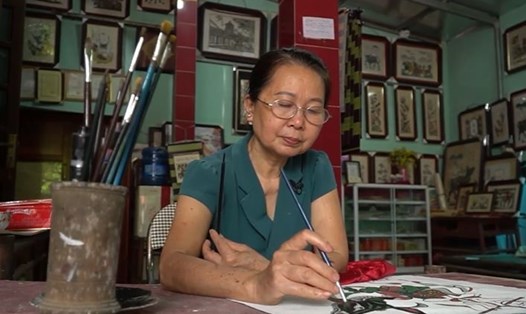Preserving the uniqueness of Dong Ho painting
Visiting Dong Ho village (Thuan Thanh district, Bac Ninh province), you can easily see the scene of the Dong Ho folk painting preservation and conservation center and the families of artisans tirelessly painting and carving. Along with the spread of the MV "Bac Bling" about Bac Ninh province, many people came to Dong Ho painting village to admire the set of paintings of To Nu Tu Bang painted by Hoa Minzy in the MV.
Talking to Lao Dong reporter, Meritorious Artist Nguyen Huu Qua shared that when watching the MV "Bac Bling", he immediately realized the scene where Hoa Minzy recreated To Nu paintings. He believes that music videos are an interesting approach to help spread traditional cultural values to the public. Because, unlike other folk paintings, Dong Ho paintings have very unique features, which is to use all natural materials to make paintings.
Dong Ho painting uses 5 basic colors: Red grated from pebbles taken from hills and mountains; blue from cajuput leaves; yellow from sophora japonica flowers, pitted flowers; white from the mountainside; black from straw, ashes of straw, bamboo leaves. To make paintings from these materials, it is necessary to go through meticulous and elaborate stages.
"After more than 50 years of working in the profession, Dong Ho painting products are still handcrafted by us, without applying modern technology. The true cultural value of Dong Ho paintings comes from the meticulous hands and enthusiasm of artisans. Dong Ho painting has its own strengths, with a long cultural tradition, as Hoang Cam once wrote, "Dong Ho painting is a fresh piggy bank/ Ethnic colors are bright on the sea".
Dong Ho paintings have many contents, expressing the dreams and aspirations of the people. Therefore, Dong Ho paintings are easy to get into people's hearts, easy to play, easy to understand. The price of the painting is also affordable, the price of a small painting is only about 50,000 - 100,000 VND.
Efforts to preserve centuries and lacquer
Over time, Dong Ho folk paintings have continuously changed and expanded in content, meeting many different social functions. For example, worship paintings to meet spiritual needs (Tigger Bridge, White tiger Bridge, cross, Quan Am, Phat To); historical and educational paintings to praise traditional national heroes (Phu Dong Thien Vuong, Ba Trung, Ba Trieu, Ngo Quyen, Quang Trung); marriage paintings to meet the need for good luck and goodness (Dai cat, Vinh hoa, Phu quy, Goat, Duong); daily paintings reflecting customs, practices, festivals, daily life of people (D document, Du Xuan, Du Du Duong Duong Duong); landscape paintings praising nature (Mai - Lan - Cuc - Truc, Xuan - Ha - Dong, To Nu paintings)...
In fact, in Dong Ho village, many people have switched to producing votive paper and other crafts, causing many difficulties for the folk painting profession.
Meritorious Artist Nguyen Huu Qua said that many young people come to research and learn a trade every year, but the number of people who stick with the trade is small. Those who learn a trade and make a living from it are mainly the next generation in families with skilled artisans.
However, Mr. Nguyen Huu Qua believes that inheriting the craft of making paintings requires many factors: First of all, people following the craft must love and deeply understand traditional culture, and have a solid foundation of knowledge. In addition, they need documents, production tools and designs to invest in a painting studio. Currently, equipping a production facility is facing many difficulties, because the cost of investing in 50 sets of painting boards alone is a challenge, not to mention printing paper, painting ink and many other tools. In particular, even with enough investment capital, finding a stable outlet for the product to ensure a livelihood for artisans is still a difficult problem.
Associate Professor, Dr. Doan Thi My Huong - Vietnam National Institute of Culture and Arts - commented that Dong Ho folk paintings face many difficulties because they have to compete with commercial products and consumer tastes have changed. She proposed a number of solutions to preserve Dong Ho paintings such as creating and combining with modern elements; strengthening international cooperation to bring paintings to museums, exhibitions and seminars.











